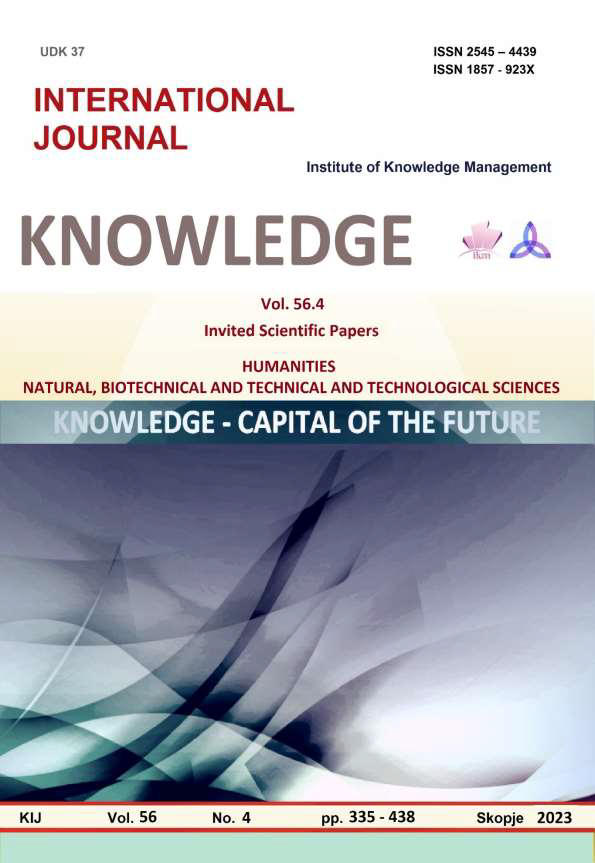CONTRASTIVE STUDY OF TERM FORMATION BASED ON SIMPLE NOUNS IN MATHEMATICS (CORPUS BASED STUDY)
Keywords:
contrastive study, English language, Slovak language, term formation, termAbstract
The article deals with a contrastive analysis of mathematical terms, i.e. simple nouns. The research
focuses on the term formation within the word class of nouns. Origins of the English and Slovak terms are analysed,
described and compared. It is expected that Latin and Greek languages are the original languages of terms in both
languages. Furthemore, Slovak terminological equivalents are compared with the English ones in term preference
the Latin/Greek term or the native term if exists. According to term formation processes, the following suffixes
representing bound morphemes are analysed: -ics, -ity, -ment as well as the Slovak suffixes of the Slovak terms
representing possible equivalents. Terms are analysed according to principles for term formation. The following
principles should be followed in the formation of terms and appellations, as far as possible and as appropriate to the
language: transparency; ⎯ consistency; ⎯ appropriateness, linguistic economy; ⎯ derivability and compoundability; ⎯
linguistic correctness; ⎯ preference for native language. Data are collected from the Slovak National Corpus 10.0,
i.e. English –Slovak Parallel Corpus 4.0 en, Slovak –English Parallel Corpus 4.0 sk and the British National Corpus.
The research is based on both languages and comparison of terms in both parts of the corpus. Specific trends and
tendencies in the strategies of term formation are analysed. Subject of analysis is the terminological level of
mathematics in the Slovak and the English language. The methods of quantitative and qualitative analysis are
applied, contrastive and comparative approaches are used. Terminology records of terms are examined from lexico -
grammatical point of view and on the basis of term-formation tendencies in each analysed language. i.e. Slovak
language and English language. Records include entry, identification number, reference to the term, synonyms,
subject field, formula, abbreviation, context, reference to the context, definition, reference to the definition.
Furthermore, the statistical value ARF (average rate frequency) is taken into consideration in order to identify the
frequency of the suffixes. It is a statistical tool representing the average occurrence of words in the corpus.
Outcomes on contrastive analysis of terms/simple nouns are discussed and illustrated in the table.
References
Bozdechová, I. (2016). Word-formation and Technical Languages. [book auth.] p.o. et al. müller. word-formation: an international handbook of the languages of europe. s.l. : walter de gruyter, 2016, vol. iii, 127., pp. 2251-2266.
Cabré, T. M. (1999). Terminology. Theory, Methods and Applications. amsterdam/philadelphia: john benjamins publishing company, 1999. 247 p. isbn 90 272 1634 7
Cíbiková, I. (2012). Terminologický manažment verejnosprávnej tematickej oblasti. žilina: žilinská univerzita v Žiline, 177 p. isbn 978-80-554-0559-9
Čižmár, J. (2009) Matematická Terminológia v školskej praxi. in: medzinárodný vedecký seminár „nové trendy v univerzitnom matematickom vzdelávaní“. trnavská univerzita, Trnava
Devlin, K. (2011) Jazyk Matematiky. jak zviditelnit neviditelné. argo, dokořán, praha. isbn 978-7363-364-6
Džuganová, B. (2002) Terminológia ako vedná disciplína. in: kultúra slova [online]. 2002, vol 36, no 3, p. 129-139. issn 0023-5202 [cit. 2022 22-11]. available on: <https://www.juls.savba.sk/ediela/ks/2002/3/ks2002-3.pdf>
Horecký, J. (1956) základy slovenskej terminológie. bratislava: vydavateľstvo Slovenskej Akadémie vied, 1956. 148 p.
Horecký, J (1962) K Herminológii matematickej jazykovedy s 193 in československý terminologický časopis, orgán československej ústrednej terminologickej komisie pri prezídiu čsav roč. i – č. 4
Horecký, J. (1994) semantics of derived words. prešov. p.j.šafárik university, 1994.
Johnson T., & Neill, H. (2018) mathematics. a complete introduction, john murray learning, london
Jones, C. et al. (1999) matematika na dlani. príroda. bratislava, 1999
Jurčacková, Z. (2002) terminológia: základné zásady, metódy a ich aplikácia. bratislava: centrum vedecko-Technických informácií sr, 2002. 72 p. isbn 80-85165-85-6
Kvetko, P. (2021) Translation Studies. Univerzita Sv.Cyrila a Metoda v Trnave, Trnava. 4. vydanie. 2021. isbn 978-80-572-0194-6
Kvetko, P. (2015) english lexicology. univerzita sv.cyrila a metoda v trnave, trnava. 2015. isbn 978 80 8105 639 0
Kudashev, I. (2013) Quality Assurance in Terminology Management. Recommendations from the Termfactory project [online]. Helsinki: University of Helsinki, palmenia centre for continuing education, Kouvola, 2013. 248 p. isbn 978-952-10-7757-9 [cit.2022-09-20]. available at: < https://puolukka.rd.tuni.fi/projectglossary/download/qa_in_tm_kudashev.pdf>
Laluha, S. et al. (2012) Matematika. maturita. prijímacie pohovory. eurolitera. bratislava
Lančarič, D. (2016) English Lexicology. kirsch. numbrecht.
Masár, I. (2000) Ako pomenúvame v slovenčine. sav bratislava.
Masár, I. (1996) Public Relations. in kultúra slova
Medek, V. et Al. (1975) Matematická Terminológia. spn. Bratislava.
Nelson, D. (2008) penguin dictionary of mathematics. 2008. Penguin Books. isbn: 0141030232
Olejár, M. et al. (2019) Zbierka vzorcov z matematiky. snowmouse. Bratislava
Pavel, S. – nolet, d. (2001) Handbook of Terminology [online]. ottawa: public works and government services canada, 2001. 172 p. available at: <http://publications.gc.ca/collections/collection_2007/pwgsc-tpsgc/s53-28-2001e.pdf>. isbn 0-660-61616-5
Pavlič, G. (2001) Školská encyklopédia matematiky. príroda. Bratislava.
The Penguin Dictionary of Mathematics, (2003) Penguin Books, London
Sageder, D. (2010). Terminology today: a science, an art or a practice? some aspects on terminology and its development. in: brno studies in english [online]. 2010, vol. 36, no. 1, p. 123-134. issn 0524-6881
Sedlačíková, B. (2012) historie matematické lingvistiky. akademické nakladatelství cerm. brno.2012 isbn 978 7204 815 1
Sokolovský, l. (2004) Dejiny a Reformy verejnej správy na slovensku. in: teória a prax.
Stefaniak, K. (2017) Terminology Work in the European Commission: ensuring high-quality translation in a multilingual environment. [online]. in: svoboda, t. – biel, ł. – łoboda, k. quality aspects in institutional translation. berlin: language science press, 2017. p. 109–121. isbn 9783946234838
Štekauer, P. (2000) rudiments of the english language. slovacontact. prešov isbn 80 88876 04 4
Termium plus: the Government of Canada’s Terminology and Linguistic Data Bank. [online]. [cit.2022-28-11]. available on: ˂https://www.btb.termiumplus.gc.ca/tpv2alpha/alpha-eng.html?lang=eng>
Trnka, B. (2014). rozbor nynĕjší spisovné angličtiny. karolinum. praha isbn 987-80-246-2434-1
UNESCO. (2005) guidelines for terminology policies. paris: unesco, 2005. 39 p. [online]. [cit. 2022-09-20]. available at: http://www.unesco.org/new/en/communication-and-information/resources/publications-and-communication-materials/publications/full-list/guidelines-for-terminology-policies-formulating-and-implementing-terminology-policy-in-language-communities/





